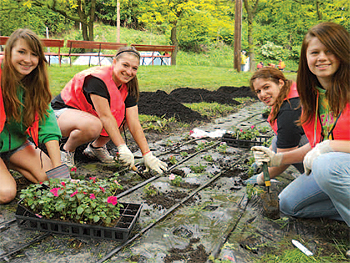Science and Research Confirms Significant Impacts of Gardens and Greenspace Program
While the more than five million people who pass Western Pennsylvania Conservancy community gardens each day may delight in their appeal, few may ponder how urban green space improves our environment and helps neighborhoods become more energy-efficient.

A group of volunteers planting a community garden on Banksville Road in Dormont
Plantings of all kinds — from street trees to baskets of petunias — promote carbon sequestration and capture storm water, according to Judy Wagner, senior program director of WPC’s Community Gardens and Greenspaces program.
“For every tree we plant, we remove 30 square feet of concrete,” said Jeffrey Bergman, director of TreeVitalize, the WPC-based partnership to restore tree canopy in Pittsburgh by planting 20,000 trees. Trees are environmental workhorses that increase in value as they grow,” he added.
A 2005 inventory of Pittsburgh street trees indicated that trees in place at that time reduced energy costs by $1.2 million per year. Trees provide shade and absorb carbon dioxide from industrial and vehicular emissions. They also slow runoff from impermeable surfaces, which is a major challenge in older cities such as Pittsburgh.
Because their canopies and roots intercept water — about 1,400 gallons per mature tree each year — trees can ease the burden on the city’s aging sewer system. Although municipalities are under a federal mandate to upgrade their infrastructure like roads, sewer and water facilities and sidewalks, improvements may be decades away, and runoff remains a problem in urban watersheds. For example, despite a $7.5 million investment in Nine Mile Run in Frick Park to protect the stream from contamination, storm events still send high levels of pollution into the stream.
As a part of the TreeVitalize work, the program is planting 500 trees in Wilkinsburg. At maturity, they will intercept at least one half million gallons of the storm water that flows into Nine Mile Run annually. With 93 trees installed this spring and more slated through next year, this $500,000 project funded by PennVest is bringing TreeVitalize closer to its 20,000-tree goal.
The tree selection process balances aesthetics with science. “Our foresters assess each and every site and hand select trees, based on the condition of sidewalks, the presence of overhead wires, and proximity to intersections and entryways,” Bergman said. “They’re sensitive to how the property is used.”
With an eye toward diversity, species that can tolerate rugged urban conditions such as pollution, compacted soil and road salt, are selected. “Our shade varieties include London plane, white oak, elms, maples and honey locust. Our lower canopy species are cherry, crabapple, hawthorn, serviceberry and hornbeam,” Bergman said.
With impetus derived from Last Child in the Woods, the bestselling book by Audubon Medal recipient Richard Louv, WPC is doing its part to reconnect children with nature. Through its School Grounds Greening project, WPC is working with all 60 Pittsburgh public schools to create natural, ecologically-diverse outdoor areas that also foster an environmental ethic.
“It’s well-documented that time spent in school gardens isn’t just calming; it helps kids to focus better,” said Wagner. “There’s strong evidence of the positive impact on youth development when you provide kids with an outdoor area that is both inviting and usable.”
Through the program, students work in teams to create low-maintenance plots with shrubs, ornamental plants and trees. The Wilkinsburg High School Key Club developed a rain garden on its grounds that include five trees.
Greener schoolyards offset energy costs, said Wagner, who recalled visiting a building where the student lunchroom measured 95 degrees before trees were added. U.S. Department of Agriculture data equates the net cooling effect from just one mature tree to 10 room air conditioners operating 20 hours a day.
“When we replace hardscape with green space, it enhances the earth’s capacity to cool things off.” Communities interested in cultivating an earth-friendly agenda will find green leads to more green, Wagner said.
“Getting things into the ground, whether it’s a rain garden or trees, is a good long-term investment,” she said. “Research suggests that when you plant even a single tree on your property or if your home is located near green space, your property value increases by at least 10 percent.”
Get Involved
You can help WPC by volunteering your time! Click here to learn more.
